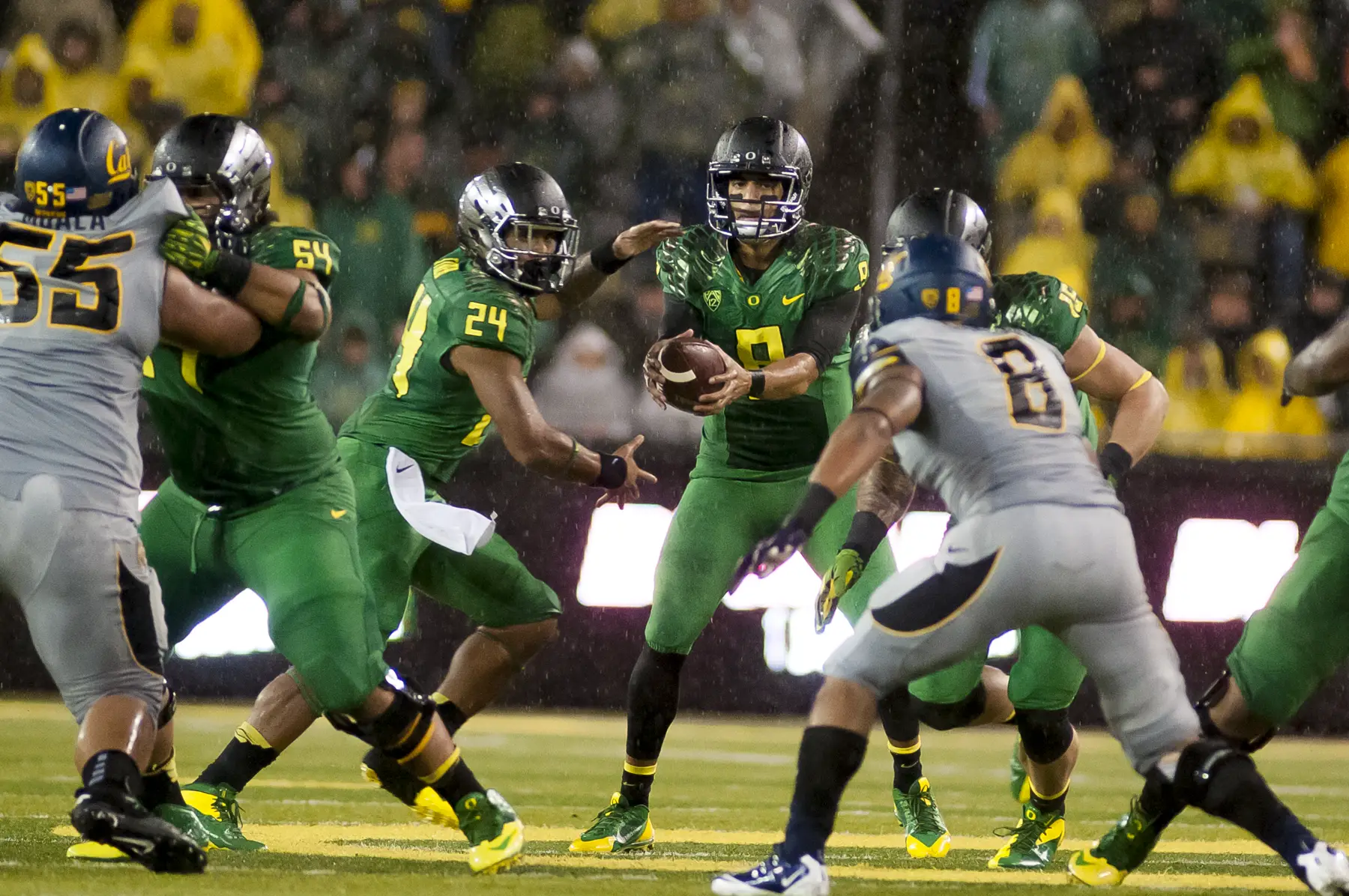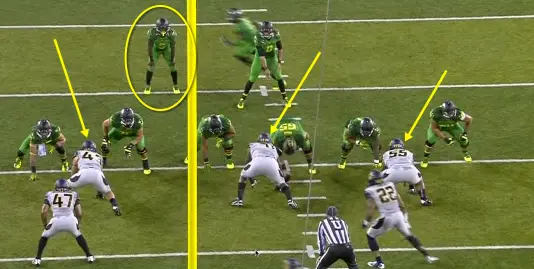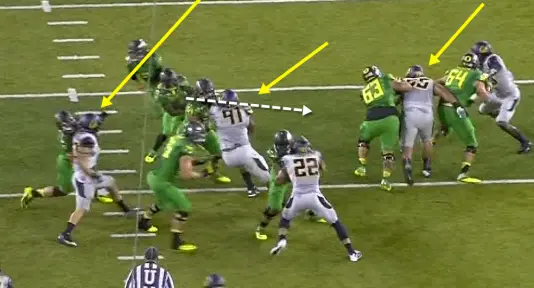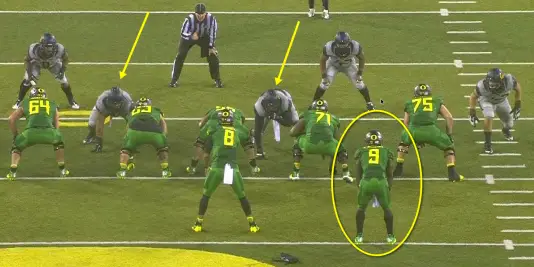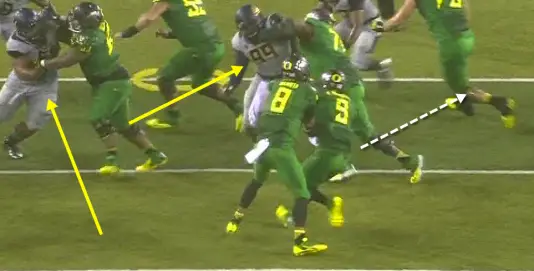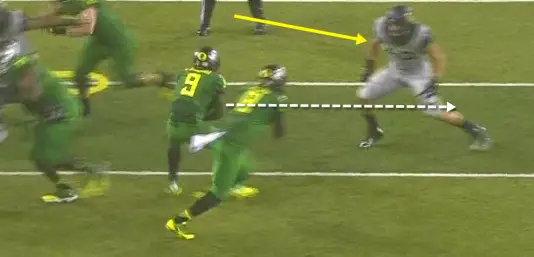As pointed out in an earlier post here at FishDuck, the Oregon Ducks have become one of the premier rushing teams in all of college football and we’ll now examine another reason why.
I have written other articles discussing some of the factor’s that play a critical role in their success running the football; including a breakdown of the zone blocking scheme and a feature on perimeter blocking. FishDuck.com has thoroughly documented Oregon’s implementation of the zone scheme and it’s many derivatives.
This analysis will add to this documentation, taking a closer look at the techniques used by Running Backs in the Inside Zone (IZ) scheme and how they are taught and drilled to exploit a defense.
A Quick Primer on the Inside Zone
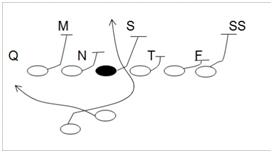 The IZ is an inside run play predicated on inducing the defense to over-pursue a play in an effort to stop the ball carrier from reaching the perimeter. This is accomplished by presenting, at least initially, a play where all lineman and the primary tailback are all moving in the same direction. The linemen are tyring to get their bodies to the play-side half of the defender to cut off their angle of pursuit.
The IZ is an inside run play predicated on inducing the defense to over-pursue a play in an effort to stop the ball carrier from reaching the perimeter. This is accomplished by presenting, at least initially, a play where all lineman and the primary tailback are all moving in the same direction. The linemen are tyring to get their bodies to the play-side half of the defender to cut off their angle of pursuit.
The ball carrier takes the ball, presses the line of scrimmage (LOS), and looks for a running lane. When it opens up, he makes a decision, and goes North-South as quickly as possible for positive yardage. The result, as we so often see with Oregon’s offense, can be large running lanes with the potential for devastating cutbacks behind over-pursuing defenders.
IZ Running Backs: Coaching ‘Em Up
Coaching a football player typically involves a series of steps known as a teaching progression. The progression usually starts with the player’s stance and initial alignment and goes through the various footwork and techniques necessary to execute their assignment. A general progression might look something like this. [NOTE: This is just a progression specific to the IZ, other things like ball security, blocking and breaking tackles are beyond the scope of this article.]
- Stance and Alignment
- Initial Steps and Aiming Point
- Pressing the LOS
- Making the Read
- Getting North-South
1. Stance and Alignment
Being in the appropriate stance and getting lined up in the correct place is critical for every player on every play. The IZ running backs stance is usually a variation of a two-point stance. This allows the player to see the field and get a pre-snap read of the defensive alignment and front. Tailback alignment in for the IZ is as variable as the number of teams that run the scheme, however, there are a few generalities that can be made.
2. Initial Steps and Aiming Point
Again, footwork may vary somewhat between systems, but the tailback’s first step will always be with his play-side foot in the direction of the call. Once the first step is in the ground, the running back then needs to get on his path to his aiming point. This is always somewhere on the play-side half of the formation. In my experience, it is usually somewhere in relation to the play-side guard, often times, the outside hip.
3. Pressing the LOS
The next step in the teaching progression for the IZ tailback is the idea of pressing line of scrimmage and being patient while the play develops. Other than making the correct read, the ability to be patient while pressing the LOS, is what makes an athlete a great IZ running back. Once the ball is in the tailback’s hands he needs to continue on his path and press the LOS, keeping his eyes up to make his reads. It is this pressing action that usually causes defenders to over-commit and open up cutback lanes. The following video provides a very basic explanation of why pressing the LOS is critical to the success of the Inside Zone.
4. Making the Read
As the back presses the line of scrimmage and patiently waits for the defense to react to his path, he needs to be watching the play develop in front of him. If the play is blocked effectively, the IZ typically presents the back with three possibilities.
From the diagram above, we can see that if the back is presented with a down hill read, then he will simply continue on his path and get “down hill” for positive yardage. If, on the other hand the down hill path is taken away by the defense and the cutback path opens up, the back needs to make a back-side cut. Keep in mind this cutback could be all the way to the backside D-Gap depending on how much pursuit the defense gives. This technique is demonstrated in the video below.
Finally, if the tailback can’t continue down hill, and the cutback lane isn’t there, it probably means the defense isn’t pursuing the play, and he can bounce it to the outside. In the video below, we get a look at a drill that helps the running backs learn to read the defense. We can see how the different possibilities present themselves and how the running back must react in each situation.
5. Getting North-South
Finally, once the tailback makes his read, he needs to accelerate through the hole. At this stage, it is important to emphasize the importance of making only one cut and then working to get positive yardage. This is commonly referred to as getting North-South. This will help eliminate indecision and reduce the occurrance of negative plays.
Seeing These Techniques on Game Day
Let’s take a look at how some of these techniques are realized on game day:
In the screen shot above, we see Oregon’s running back Byron Marshall in a 2-point stance with an alignment to the offensive right at about 5.5 yards. The arrows point out the defender’s that he may have to “read” in order to make his decision.
Here, in the screen shot above, we see Marshall pressing the line of scrimmage and looking to make his cut. We can see that all of the potential “read” defenders are fighting to maintain control of the play-side gap. It is possible that Marshall should have cut it back as the defenders are all pursuing hard to the play-side, however, his lineman are able to maintain their blocks long enough for him to continue to bounce the play outside.
Above we see that as the play progresses, the running lane opens up, and Byron is able to accelerate through the hole.
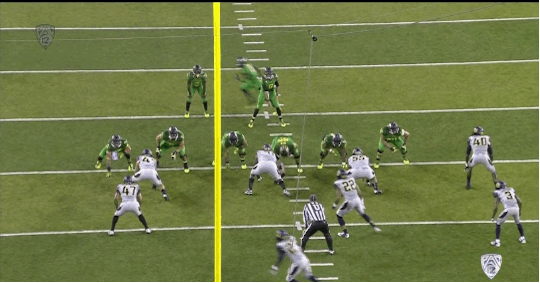
The above clip illustrates that despite possibly making the wrong read, Marshall is able to make a play to the outside and ultimately score.
In another example of the Inside Zone, Byron demonstrates the cutback read.
Above, we again see Marshal in a two-point stance. With a pre-snap look at the defensive front, he can see the defenders that will likely influence his read.
In the screen shot above, we see both “read” defenders fighting to the play-side. This time Marshal makes the decision to cut back underneath the pursuit.
Above, we see that after making his cutback, there is another defender waiting for him. In this instance, he decides to bounce it to the outside.
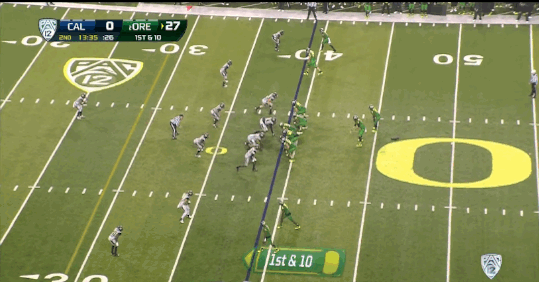
No down hill or cutback, but Byron has the bounce!
A Few More Examples
The following examples show the wide-angle view of Oregon running back D’Anthony Thomas making a cutback. These illustrate how the cutback can be very effective when the back makes one cut and gets North-South into the running lane.
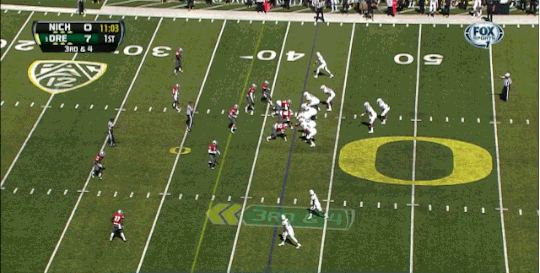
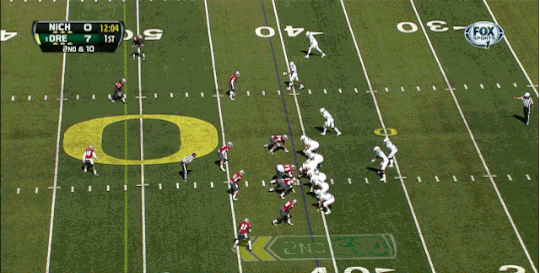
Final Thoughts
The Inside Zone is a great running play, and if players are taught how to execute properly, it can be devastatingly effective. Throw in top-notch athletes who are able to implement the techniques outlined above and you get an offense like Oregon’s. As a result of their effort, we see an offense that is consistently able to make big gains in the run game and light up the scoreboard.
Obviously it takes a lot of time and effort from both players and coaches to get this system in place and run it well, but when it all comes together it is a lot of fun to watch.
Coach Levi Steier
Albany, New York
http://optionfootball.net
Feature image courtesy of Craig Strobeck.
Levi Steier, (Football Analyst) after a collegiate playing career cut short by injuries, began his coaching career as a student assistant at Dakota State University. Since then he has coached primarily at the high school level. During this time he has been a head coach and has coordinated all three phases of the game. He is currently the owner of a web design business and the publisher at OptionFootball.net where he discusses many aspects of football, but regularly focuses on option oriented football topics. Coach Steier enjoys talking football and encourages anyone who would like to discuss the game or find more information to visit his site. You can follow Levi on twitter @OptionFootball, on his Facebook page and on Google+.

